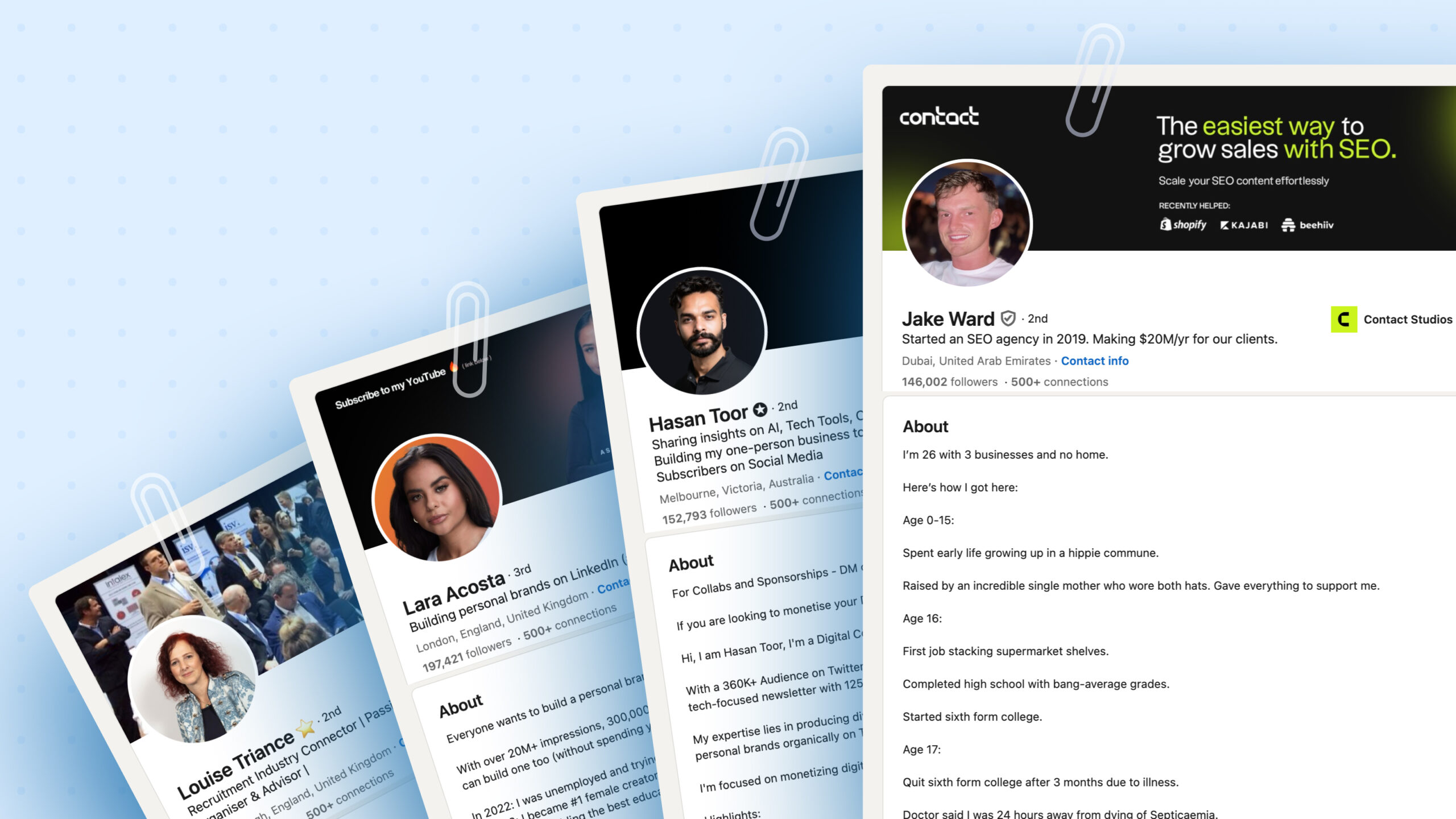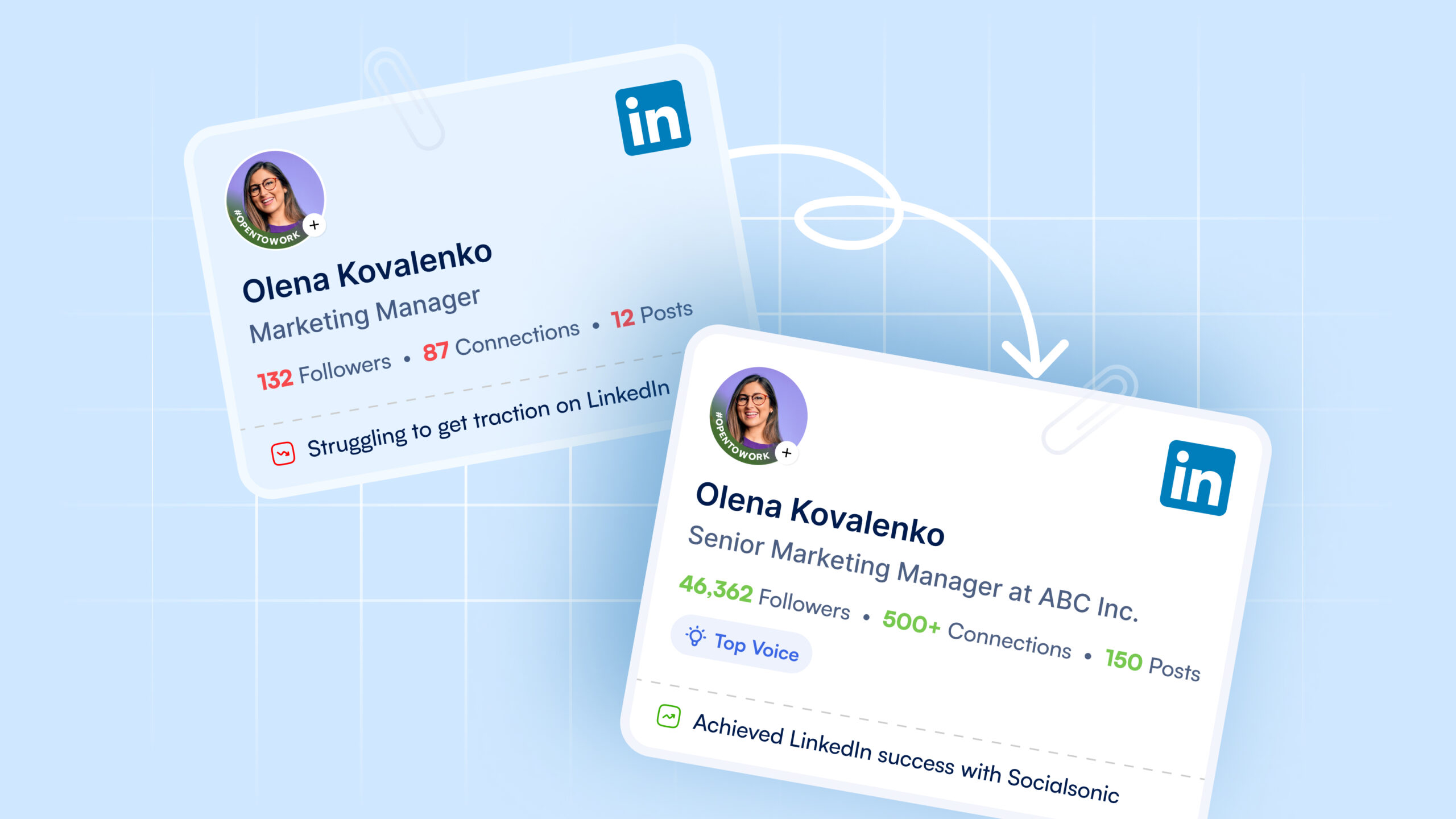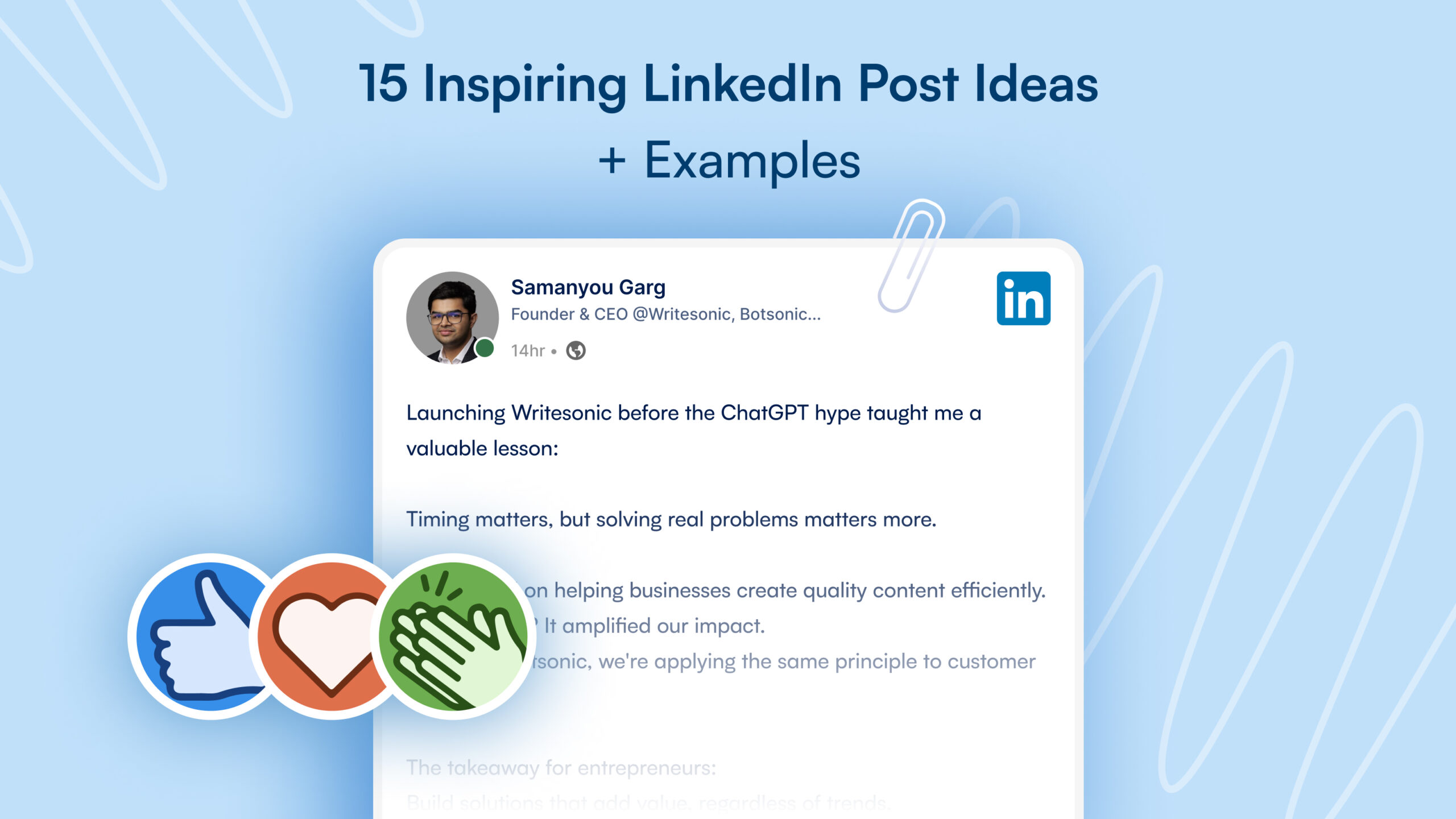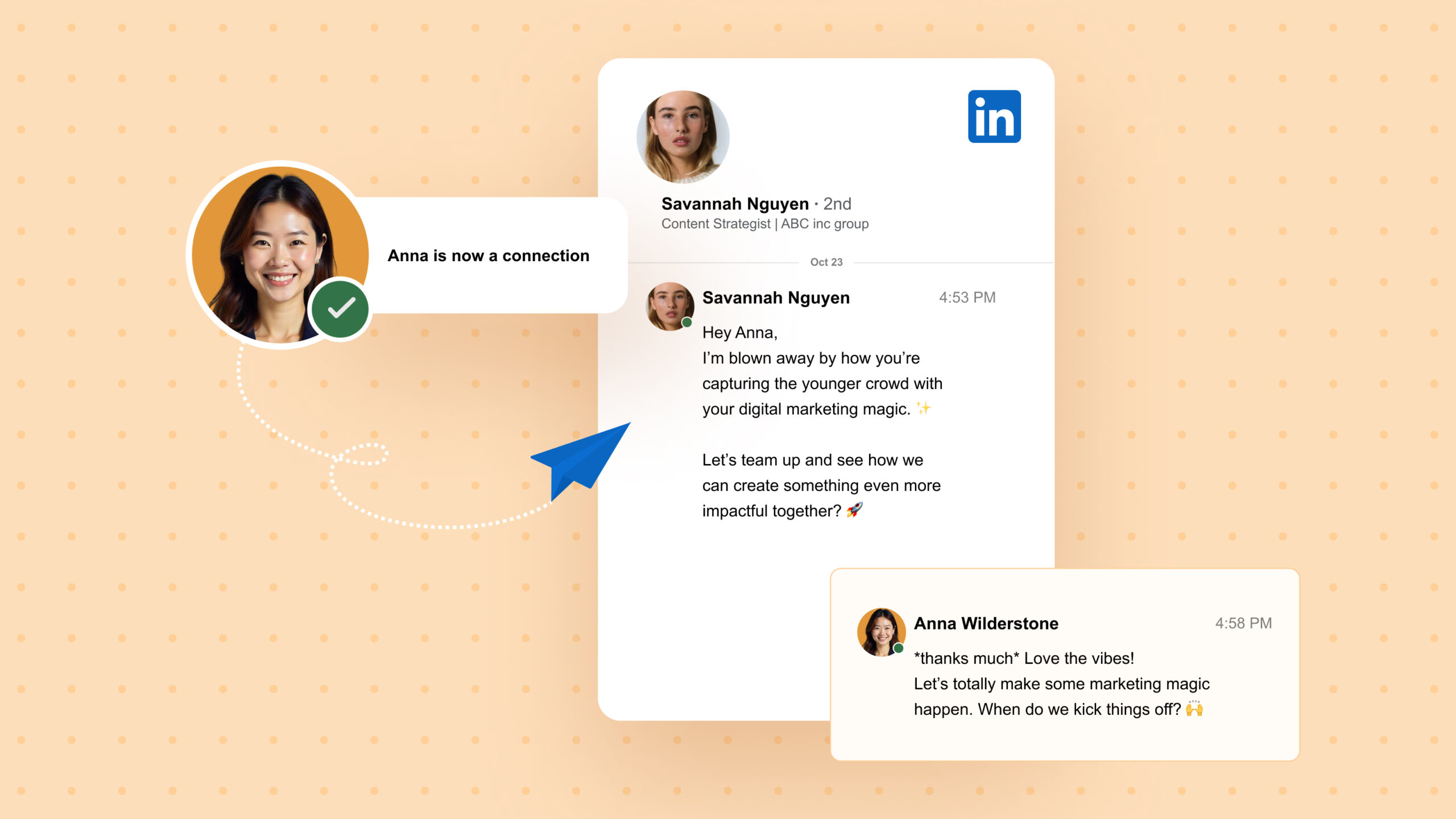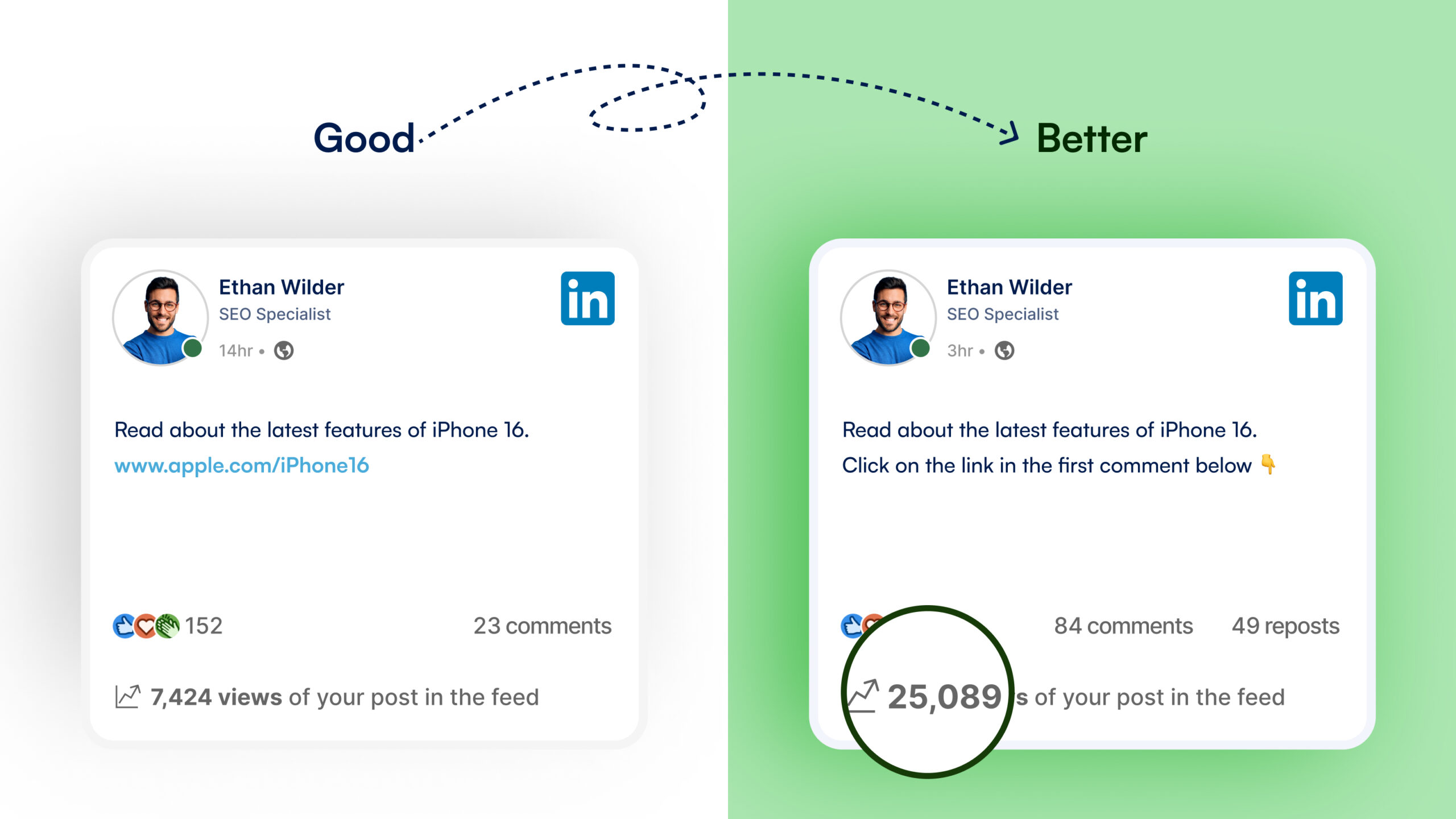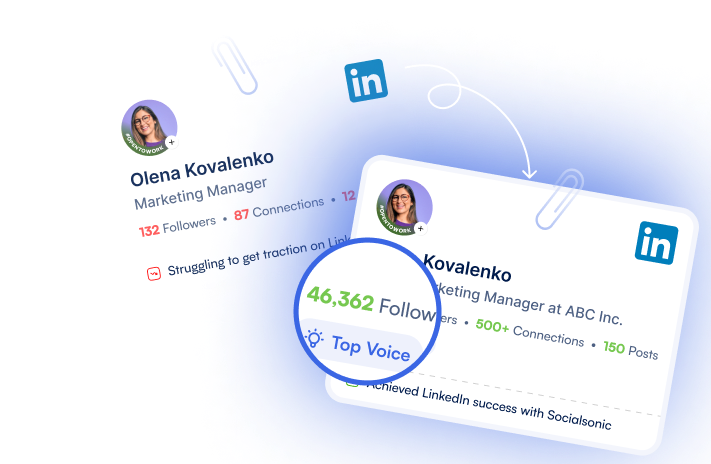Your LinkedIn summary is your digital elevator pitch—a snapshot of your professional journey that can capture or lose attention in seconds.
With so many potential connections, recruiters, and clients browsing LinkedIn daily, your summary can make the difference between getting noticed or blending into the crowd.
The challenge lies in writing a summary reflecting your personality and expertise.
You want your LinkedIn bio to be professional yet still feel authentic and engaging without sounding forced.
To help you with this, we did some digging and gathered compelling LinkedIn summary examples that can serve as inspiration.
Whether you’re just starting out as a fresh graduate, switching industries, or an entrepreneur, these LinkedIn profile summary examples will help you create an about section that stands out and opens doors.
What is a LinkedIn summary?
A LinkedIn summary, also known as the “About” section, is one of the most essential parts of your profile.
This 2,600-character section of your LinkedIn profile gives you a chance to go beyond job titles and tell your professional story in a more engaging and personal way.
Think of your summary as a cover letter.
Remember, it’s designed to provide more context than your resume, and it’s an excellent opportunity to show off your personality.
LinkedIn even states that your summary is the first thing recruiters look at when viewing profiles. This makes the summary section key to boosting your visibility on the site.
Here are some more reasons why your LinkedIn summary matters:
- Improves visibility: Using industry-specific keywords helps your profile rank higher in LinkedIn searches, attracting more views.
- Creates a solid first impression: It’s often the first thing people read, setting the tone for how you’re perceived.
- Builds personal branding: Craft a narrative that emphasizes your strengths and unique qualities, helping you stand out.
- Encourages connections: A compelling summary invites engagement and expands your network.
- Encourages contact: Listing your email or website ensures visitors know how to get in touch. Ending off with a CTA that drives visitors to connect, reach out, or visit your website.
💡Also read: The Best Time to Post on LinkedIn: 2024 Edition
10 good LinkedIn summary examples to inspire your own
1. Jake’s story telling approach
This is an interesting LinkedIn summary example from Jake Ward’s profile, as it grabs your attention and forces you to read until the end.
Here’s why it works:
- Attention-grabbing hook: Opening with “I’m 26 with 3 businesses and no home” sparks immediate curiosity.
- Chronological storytelling: By mapping his journey from childhood to professional life, Jake keeps readers engaged with a clear timeline.
- Vulnerability: Sharing personal struggles (e.g., illness, dropping out) humanizes his profile.
- No jargon: The simple, conversational tone makes his story approachable, while still subtly highlighting achievements like making $20M/year.
2. Hasn’s structured LinkedIn summary
Hasan Toor’s LinkedIn summary is a great example of a clear, structured approach that efficiently communicates his expertise and achievements. Here’s what makes it effective:
- Strong, specific call to action: Hasan opens with a clear invitation for collaborations and sponsorships, making it easy for potential clients to understand how they can work with him.
- Expertise with metrics: He highlights his social media marketing success using specific metrics (e.g., “Grew a 350K+ audience in just 12 months”), adding credibility to his accomplishments.
- Clear list of services: By bullet-pointing his services, Hasan makes his offerings easy to scan, giving potential clients a quick overview of what he provides.
- Direct and actionable CTA: Hasan includes multiple ways to contact him, ensuring that readers can easily engage for business opportunities.
3. How Lara turns personal branding into her success story
This summary from Lara Acosta showcases her rise as a personal branding expert, blending impressive stats with a relatable journey.
Here’s why this LinkedIn summary example shines:
- Impressive metrics upfront: Lara hooks readers with 20M+ impressions and 300,000 followers, solidifying her credibility.
- Progressive timeline: By highlighting her journey from 2022 to 2024, she keeps the reader engaged with her evolving success.
- Strong social proof: Her experience with 500+ clients provides solid evidence of her expertise in content systems and engagement strategies.
- Effective CTAs: Clear steps for further engagement—whether it’s subscribing or joining her academy, which make the profile actionable and interactive.
4. Louise Triance’s expertise in action
Louise Triance’s LinkedIn summary is simple and to the point, yet effective.
Her About section is a great example of how LinkedIn summaries don’t have to be elongated and full of stories.
Here’s why her summary is effective:
- Industry authority: Louise positions herself as a recruitment thought leader by emphasizing her creation and leadership of the UK Recruiter network. She clearly highlights important metrics like her role in establishing a trusted resource for over 30,000 professionals.
- Extensive experience: She clearly outlines her decades-long career by mentioning the hundreds of events she has hosted and the 1000+ newsletters published, building strong social proof.
- Specialized skill set: Louise concisely lists her specialties, such as recruitment research, psychometric analysis, and event organization, which makes her expertise clear and relevant to her audience.
- Call to action and contact points: She finishes her summary with multiple links to her professional platforms, ensuring potential clients or collaborators can easily connect with her.
5. Sharon’s clear and conversational LinkedIn summary

Sharon M.’s LinkedIn summary is straightforward and easy to read, making it highly effective for busy recruiters or connections. Here’s why it stands out:
- To the point: Sharon immediately states her current role as a Senior Content Lead in the B2B SaaS space, giving readers a clear understanding of her expertise.
- Conversational tone: The language is simple and approachable, avoiding jargon while still being professional, which makes her summary relatable.
- Toolkit expertise: She efficiently lists her extensive toolkit (WordPress, HubSpot, Google Analytics, SEO, etc.), showcasing her technical skills without overwhelming the reader with too much detail.
- Education snapshot: Sharon highlights her multiple degrees but keeps it concise, emphasizing that she values continuous learning with a lighthearted touch (“Learning is fun!”).
💡You might also like: How to Improve LinkedIn Profile in Under 10 Minutes
6. Ishan’s journey from college dropout to entrepreneur
Another interesting storytelling approach we love is this LinkedIn summary example from Ishan Sharma.
His About section reflects his entrepreneurial journey and passion for helping others grow in their careers in an engaging manner. This is also works as a great LinkedIn summary example for students who want to highlight personal projects.
Here’s why it shines:
- Authenticity and relatability: Ishan opens by sharing that he’s in the “best phase” of his life, immediately creating a positive, relatable tone. His openness about dropping out of college to focus on his business makes him relatable to young professionals and aspiring entrepreneurs.
- Collaborative success: Ishan mentions influential guests from his podcast (Nikhil Kamath, Noah Kagan), which adds social proof and highlights his network of influencers.
- Storytelling through milestones: Ishan shares his journey from publishing books (with bestselling status on Amazon) to delivering speeches at 15+ colleges, making his accomplishments feel tangible and impactful through an engaging manner.
7. Fernando’s conversational and relatable LinkedIn summary
Fernando Parada’s LinkedIn summary is a great example of how to create a relatable, conversational tone while still highlighting professional expertise.
Here’s why it stands out:
- Conversational and approachable tone: Fernando’s summary feels like a conversation, making it accessible and easy to read. This informal approach helps break down barriers and builds instant rapport with the reader.
- Focus on the human element: By emphasizing that recruiting is about people, Fernando positions himself as a professional who values relationships, trust, and advocacy, which resonates well with both clients and candidates in the recruiting industry.
- Personal touch without losing professionalism: His mix of professional insights with personal interests (hobbies like bouldering and guitar) adds a human element, which makes the profile more engaging and memorable without distracting from his skills.
- Unique blend of technical and people skills: He creatively uses a coding reference (Python) to reflect his technical expertise, blending his understanding of the tech field with his human-centered recruiting approach.
8. Christa’s short and sweet introduction
Even though Christa J. Dias’ LinkedIn summary is short, it ticks off all the right boxes.
Here’s why it works so well:
- Friendly and engaging greeting: The opening line “Hi 👋, I’m happy you stopped by!” makes the profile approachable and personable, setting a welcoming tone right away.
- Clear and concise expertise: In just a few lines, she communicates her 5+ years of experience in recruitment and employee engagement, covering diverse industries such as aviation, finance, and tech, without any fluff.
- Comprehensive skills and tools: Christa clearly mentions her wide range of skills (event management, mentorship, diversity & inclusion) and tools (Google Suite, Greenhouse, Notion) into a quick, easy-to-scan format, making it recruiter-friendly.
- Brief but powerful: Despite its brevity, her summary delivers a clear value proposition, demonstrating that short doesn’t mean less impactful.
9. Irina’s results-driven LinkedIn summary
Irina Maltseva’s LinkedIn summary is concise yet highly effective, focusing on her inbound marketing expertise for SaaS companies.
Here’s why her summary serves as a solid example:
- Clear value proposition: Right from the start, Irina clearly states that she helps SaaS companies grow their revenue through inbound marketing, making her focus obvious.
- Experience-driven: With 10+ years in marketing, she establishes credibility quickly by mentioning her diverse experience with corporations, startups, and social projects.
- Actionable advice: The use of bullet points adds structure and offers useful tips for SaaS marketers, keeping the content engaging and informative.
- Proven results: Irina includes specific achievements, like helping Aura grow from 30K to 850K organic traffic, showcasing her ability to deliver measurable outcomes.
10. Sophia’s conversational and mission-driven LinkedIn bio
Sophia Valdez’s About section is an excellent example of how to engage readers with authenticity and purpose while maintaining a conversational tone.
Here’s why we love this LinkedIn summary example:
- Personal connection: Sophia’s introduction feels personal and approachable, making her mission clear without sounding overly formal. Starting with a life goal draws readers in right away.
- Clear mission and values: Rather than focusing on roles and titles, Sophia emphasizes her mission—to break down barriers and create opportunities for others. This makes the summary purpose-driven and inspiring.
- Easy-to-read structure: The use of short, clear sentences and headings like “My Mission” makes the summary easy to scan, ensuring key points stand out.
- Relatable storytelling: By sharing her background and journey, Sophia humanizes her profile, making it easy for readers to connect with her on a personal level.
- Warm and welcoming tone: The casual language and fun use of emojis create a relaxed tonality, making her CTA feel accessible and inviting.
💡You might also like: Top 30 Content Marketing Influencers You Need to Follow
How to write a LinkedIn summary: 10 essential tips

Now that we have an idea of what good LinkedIn summary examples look like, let’s get into the details of how to write one that truly stands out.
Crafting a LinkedIn summary is a blend of strategy and storytelling, and when done right, it can open doors to new opportunities, connections, and collaborations.
Here are seven essential tips to guide you through creating a summary that’s engaging and optimized for LinkedIn’s platform.
1. Start with a compelling hook
Your LinkedIn summary should grab attention right from the start.
The first few lines are critical because LinkedIn only shows the first three lines before visitors have to click “see more.”
Your opening should be captivating enough to make people want to read further.
According to career expert Hannah Morgan, it’s important to know exactly how you want to describe and position yourself so your audience has a clear understanding of what exactly you do.
And this starts with a strong hook in your summary that can help break through the noise and showcase your personality.
How to do this: Start with a unique statement, an interesting fact about your career journey, or a bold question that connects with your audience. Avoid starting with something generic like your job title—focus on what makes your story interesting.
For example:
“After spending a decade in marketing, I realized my passion isn’t just in brand strategy—it’s in helping companies discover their unique voice and stand out.”
2. Convey your career story, not just your job title
Your LinkedIn summary should reflect your professional journey, not just the roles you’ve held.
People connect with stories, and by sharing a narrative that highlights why you do what you do, you humanize your profile.
How to do this: Structure your summary like a brief career timeline, touching on the moments that mattered the most.
Instead of listing responsibilities, focus on how you got started, what drives you, and how your skills have evolved. This gives readers a deeper insight into your career path.
For example:
“I started my career as a data analyst, fascinated by the power of numbers. Over the years, I’ve transformed that passion into helping businesses make data-driven decisions that grow their bottom line.”
This keeps the tone personal and relatable while still remaining professional.
3. Use industry-specific keywords for SEO
Search engine optimization (SEO) doesn’t just apply to websites—it’s crucial for getting noticed by the LinkedIn algorithm as well.
By integrating relevant keywords into your summary, you increase your chances of appearing in LinkedIn’s search results.
According to LinkedIn, profiles that are keyword-optimized can get up to 40% more search appearances.
How to do this: Look at job descriptions of the kind of roles you want to apply for or the profiles of people in your industry to find common terms and phrases recruiters search for.
Naturally weave these keywords into your summary so they flow seamlessly with your story. This can look something like:
“With a focus on digital marketing strategies, SEO optimization, and social media management, I’ve helped brands increase their online visibility and reach new audiences.”
4. Break up your text with clear sections
A well-structured summary is easier to read and digest.
Large blocks of text can be overwhelming, especially for busy recruiters or potential connections.
Using clear sections to improve readability, keeps readers engaged and makes your summary feel more organized.
Keep in mind that a longer LinkedIn summary doesn’t necessarily mean you’ll get more eyeballs on your profile.
If you want to keep your About section on the longer side, make sure it is well structured and doesn’t look like one big chunk of text.
How to do this: Divide your summary into three main parts: a short introduction (who you are), a middle section (key skills or achievements), and a conclusion with a call-to-action (what you want the reader to do next).
You can even use bullet points to highlight your key accomplishments or skills and even emojis to make it easier to read.
Try structuring your LinkedIn summary like this:
“Here’s what I bring to the table:
- Expertise in content marketing and SEO strategy
- Experience leading cross-functional teams
- Proven track record of increasing web traffic by 30% annually”
This structure makes it easy for readers to skim while also highlighting your value.
5. Mention what you’re currently looking for
Your LinkedIn summary should be customized for the specific audience you’re trying to attract.
Whether you’re looking for a job, building a personal brand, or seeking clients, your summary should address their needs and interests.
Tailoring your message to align with your professional goals makes your profile more engaging and increases the chances of connections that matter.
How to do this: Think about your primary audience and what they’re looking for.
If you’re job hunting, make it clear what roles you’re seeking and how your skills fit.
For freelancers or entrepreneurs, focus on the services you provide and how you solve client problems.
You can even mention whether you’re open to hiring or not.
6. Include social proof to highlight your achievements
Your LinkedIn summary should not only tell people what you’ve done but also how well you did it.
By incorporating social proof—such as the names of reputable companies you’ve worked with, awards you’ve earned, or significant projects you’ve completed—you build credibility and trust.
This data-driven approach shows potential employers or clients that your contributions are backed by real results and external recognition, making your profile more compelling and persuasive.
How to do this: Wherever possible, highlight specific, quantifiable outcomes from your work. Use numbers to tell a story of success.
For example, rather than saying you “improved customer satisfaction,” mention that you “increased customer satisfaction scores by 25% over six months.”
Here’s another example:
“I’ve had the pleasure of working with top-tier clients, including Microsoft and Adobe, helping them build marketing strategies that drove their sales by 20%.”
7. Be conversational and show your personality
While LinkedIn is a professional platform, your summary doesn’t have to be robotic or overly formal.
Keeping the tone conversational and approachable will help you stand out from the sea of overly technical or rigid profiles.
Think of your summary as an introduction at a networking event—authentic, relatable, and still professional.
How to do this: Write as if you’re speaking directly to someone.
Use the first person (“I,” “me”) to make your summary feel personal and engaging. Sharing a bit about your personality—whether it’s a hobby or an interesting fact—can also make your profile more memorable and relatable.
Example:
“I’ve always loved solving puzzles, whether it’s a tricky client challenge or a weekend Sudoku. As a project manager, I bring that same passion for problem-solving to every project I lead.”
This kind of conversational tone gives your profile a human touch, making it more likely that potential connections will engage with you.
8. Keep it concise and avoid jargon
Your LinkedIn summary should be clear, concise, and free from industry jargon.
While it’s tempting to use complex language to sound knowledgeable, jargon can alienate your audience and make your profile harder to understand.
A study by Harvard Business Review found that simpler, straightforward language tends to resonate more with professionals, making your profile more approachable.
For example, instead of: “I specialize in leveraging agile methodologies to optimize synergistic workflows.”
Try: “I help teams work more efficiently by simplifying their processes and improving collaboration.”
This approach makes your summary more readable and ensures that your audience can quickly grasp what you do, regardless of their background.
9. Add a strong call-to-action (CTA)
Your LinkedIn summary should not just describe what you’ve done—it should direct the reader to the next step.
Adding a call-to-action gives readers clear guidance on how they can connect with you, engage in collaboration, or learn more about your work.
In fact, profiles with CTAs tend to have higher engagement rates because they invite the reader to take action.
How to do this: Make it easy for people to contact you. Whether you’re inviting them to connect, message you for collaborations, or visit your website, your CTA should be clear and actionable.
Example:
“Interested in learning more about how I can help your business grow? Feel free to connect or send me a message, and let’s explore how we can work together.”
10. Update your LinkedIn summary regularly
Your LinkedIn summary shouldn’t be static.
This section of your profile should reflect where you are in your career right now.
As you gain new skills, take on new roles, or complete major projects, it’s crucial to keep your profile updated.
LinkedIn’s own research shows that regularly updated profiles are much more likely to appear in search results and attract the right kind of attention from recruiters.
Consider setting a reminder to revisit your summary every 6-12 months.
Add any major career shifts, newly acquired skills, certifications, promotions, or notable achievements. This not only keeps your profile fresh but also demonstrates that you’re actively engaged in your field.
LinkedIn summary mistakes to avoid
When crafting your LinkedIn summary, there are a few common pitfalls that can reduce its effectiveness or make your profile seem less appealing.
To ensure your summary is engaging and professional, steer clear of these mistakes:
1. Making it a resume dump
One of the biggest mistakes is turning your summary into a list of past jobs or achievements.
LinkedIn already has sections for experience and education, so don’t waste your summary space repeating information. Instead, use this section to tell your story and highlight your unique value.
While it’s great to showcase personality, over-sharing personal stories can make your summary lose its professional touch.
2. Overloading with personal details
Stick to sharing relevant personal details that support your career story or goals.
3. Using passive language
Weak or passive language can make your summary less compelling.
Phrases like “responsible for” or “involved in” fail to convey the full extent of your contributions. Instead, opt for action verbs and results-focused statements, showing exactly what you achieved.
4. Being too generic
Terms like “hard-working” or “team player” are overused and don’t set you apart from others.
Use specific language to describe your skills, achievements, and what makes you different from other professionals. Highlight exactly what you’ve worked on, the type of tools you have experience with, your work environment and projects.
5. Spelling or grammatical errors
Nothing undermines your professionalism like a summary riddled with spelling or grammatical mistakes.
Even a small error can cause a recruiter to doubt your attention to detail. Use tools like Grammarly or ask someone to proofread your summary to avoid embarrassing mistakes.
5 LinkedIn summary templates you can use for your profile
Ready to revamp your own LinkedIn summary?
Here are some engaging templates you can use instantly! Just make sure you tweak the template to your liking and fill each section and placeholder with the correct content.
1. Casual, storytelling summary for creatives
“It all started with a sketchpad and a wild imagination.
I’m [Name], a [Job Title], and for the last [X] years, I’ve been turning ideas into visuals that connect brands with their audiences.
From working with [Specific Clients/Projects] to pushing the boundaries of [specific skills like design, writing, or video editing], I thrive on creative challenges.
When I’m not creating for clients, you’ll find me exploring new art forms, or perhaps geeking out over the latest design trends. Let’s connect and talk about how creative solutions can bring your vision to life.”
Why it works: This template uses a relaxed tone and taps into a creative, narrative-driven style, ideal for those in fields like graphic design, writing, or media.
2. Data-driven, professional summary template for tech
“I’m [Name], a [Tech/Engineering Role], focused on delivering data-driven results in the [Industry].
With over [X] years of experience working on [specific technical projects or tools], I’ve optimized processes that save companies time and money.
At [Current Company], I lead projects that have improved [specific outcome] by [specific metrics], and I’m always exploring ways to make systems more efficient.
Whether it’s coding, automating workflows, or diving into analytics, I’m committed to solving complex problems.
Let’s connect if you’re interested in discussing how data and technology can transform businesses.”
Why it works: This is clean, concise, and professional, highlighting measurable achievements while using technical jargon that resonates with the audience.
3. Warm, purpose-driven summary for service-oriented roles
“For me, it’s all about making a difference.
I’m [Name], and I’ve spent the last [X] years in the non-profit/healthcare sector, working to improve the lives of [specific group].
From [specific project or achievement], I’ve seen firsthand the impact that thoughtful programs and dedicated service can have.
At [Current Organization], I manage [specific responsibilities], focusing on [specific goal, e.g., community outreach, patient care].
I’m passionate about building a future where [specific outcome], and I’d love to connect with others who share that vision.”
Why it works: This template has a compassionate, heartfelt tone ideal for those in service-oriented roles as it clearly states a mission and invites others to engage.
4. Bold, entrepreneurial summary for entrepreneurs
“I’ve never been one to follow the beaten path.
As the founder of [Startup Name], I’ve taken my passion for [specific industry] and turned it into a thriving business.
What started as [small beginning or challenge] has now grown into a [specific achievement like number of clients, revenue, or market presence].
I specialize in [key skill sets], and I’ve helped [specific clients/companies] achieve [specific outcome].
Entrepreneurship has been a wild ride, but I wouldn’t trade it for anything.
Let’s connect if you’re interested in how I can help your business [specific goal].”
Why it works: This template is direct, energetic, and designed to capture the mindset of entrepreneurs and business owners. It also highlights success and growth while remaining conversational.
5. Concise, results-focused for sales professionals
“Hi, I’m [Name], a results-driven sales professional with [X] years of experience in the [industry].
I’ve helped companies like [Specific Clients] increase their revenue by [specific percentage] through strategic partnerships and personalized solutions.
Currently, at [Company], I lead initiatives to drive growth by identifying and solving customer pain points.
My goal is simple: Deliver measurable results.
Let’s connect if you want to discuss how I can help you grow your business.”
Why it works: This summary template is short, to the point, and emphasizes measurable outcomes—perfect for sales professionals who want to focus on results without being overly wordy. The strong CTA also leaves the summary on an actioanable note.
Ready to take your LinkedIn profile to the next level?

Polishing up your LinkedIn summary is just step one.
The real game-changer is staying active, showing up on peoples’ feed, and making your profile come alive with regular, thoughtful interactions.
But let’s be real—managing all that can feel like a full-time job.
That’s where Socialsonic saves the day.
Just let AI set your content schedule, engage with your network, and respond to key conversations automatically—while you focus on bigger goals.

